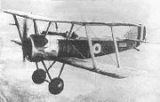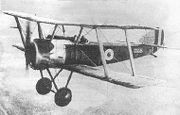
Joseph Stewart Temple Fall
Encyclopedia
Joseph Stewart Temple Fall DSC & Two Bars
, AFC
(17 November 1895 - 1 December 1988) was a Canadian
World War I
flying ace
with 36 credited victories.
on 23 August 1915.
 He flew a Sopwith Pup
He flew a Sopwith Pup
for some time in 3 Squadron, Royal Naval Air Service before he achieved his first success on 6 April 1917. A Halberstadt D.II
dived on him with a frontal attack; Fall half-looped onto the German plane's tail and fired 50 rounds to down him. Fall would score 7 more victories before changing planes to the Sopwith Camel
. He would score 5 more shoot-downs with 3 RNAS, using the Camel.
On 30 August 1917, he was transferred to 9 Squadron, RNAS as a flight commander, still flying Camels. He claimed another 23 victories with 9 Naval, with the final one occurring on 22 December 1917.
Falls' claims tally consisted of 11 (and 12 shared) aircraft destroyed, 10 (and 3 shared) 'out of control'.
Fall stayed in the Royal Air Force
from its inception on 1 April 1918 until he retired as a Group Captain in 1945. He died in 1988.
Distinguished Service Cross (United Kingdom)
The Distinguished Service Cross is the third level military decoration awarded to officers, and other ranks, of the British Armed Forces, Royal Fleet Auxiliary and British Merchant Navy and formerly also to officers of other Commonwealth countries.The DSC, which may be awarded posthumously, is...
, AFC
Air Force Cross (United Kingdom)
The Air Force Cross is a military decoration awarded to personnel of the United Kingdom Armed Forces, and formerly also to officers of the other Commonwealth countries, for "an act or acts of valour, courage or devotion to duty whilst flying, though not in active operations against the enemy"...
(17 November 1895 - 1 December 1988) was a Canadian
Canada
Canada is a North American country consisting of ten provinces and three territories. Located in the northern part of the continent, it extends from the Atlantic Ocean in the east to the Pacific Ocean in the west, and northward into the Arctic Ocean...
World War I
World War I
World War I , which was predominantly called the World War or the Great War from its occurrence until 1939, and the First World War or World War I thereafter, was a major war centred in Europe that began on 28 July 1914 and lasted until 11 November 1918...
flying ace
Flying ace
A flying ace or fighter ace is a military aviator credited with shooting down several enemy aircraft during aerial combat. The actual number of aerial victories required to officially qualify as an "ace" has varied, but is usually considered to be five or more...
with 36 credited victories.
Early life
Fall was born into a farming family on Vancouver Island, British Columbia. He tried to enlist in the army but was rejected because he had suffered a head injury when he was a child. However, he was accepted as a candidate for the Royal Naval Air ServiceRoyal Naval Air Service
The Royal Naval Air Service or RNAS was the air arm of the Royal Navy until near the end of the First World War, when it merged with the British Army's Royal Flying Corps to form a new service , the Royal Air Force...
on 23 August 1915.
Military service
The Canadian government would not support a flying school, so Fall went to England for training. He left Canada on 12 November 1915, and was in England in January 1916.
Sopwith Pup
The Sopwith Pup was a British single seater biplane fighter aircraft built by the Sopwith Aviation Company. It entered service with the Royal Flying Corps and the Royal Naval Air Service in the autumn of 1916. With pleasant flying characteristics and good maneuverability, the aircraft proved very...
for some time in 3 Squadron, Royal Naval Air Service before he achieved his first success on 6 April 1917. A Halberstadt D.II
Halberstadt D.II
The Halberstadt D.II was a biplane fighter aircraft of the Luftstreitkräfte that served through the period of Allied air superiority in early 1916, but had begun to be superseded in the Jagdstaffeln by the superior Albatros fighters by the autumn of that year.-Design and development:The D.II was...
dived on him with a frontal attack; Fall half-looped onto the German plane's tail and fired 50 rounds to down him. Fall would score 7 more victories before changing planes to the Sopwith Camel
Sopwith Camel
The Sopwith Camel was a British First World War single-seat biplane fighter introduced on the Western Front in 1917. Manufactured by Sopwith Aviation Company, it had a short-coupled fuselage, heavy, powerful rotary engine, and concentrated fire from twin synchronized machine guns. Though difficult...
. He would score 5 more shoot-downs with 3 RNAS, using the Camel.
On 30 August 1917, he was transferred to 9 Squadron, RNAS as a flight commander, still flying Camels. He claimed another 23 victories with 9 Naval, with the final one occurring on 22 December 1917.
Falls' claims tally consisted of 11 (and 12 shared) aircraft destroyed, 10 (and 3 shared) 'out of control'.
Fall stayed in the Royal Air Force
Royal Air Force
The Royal Air Force is the aerial warfare service branch of the British Armed Forces. Formed on 1 April 1918, it is the oldest independent air force in the world...
from its inception on 1 April 1918 until he retired as a Group Captain in 1945. He died in 1988.
Honours and awards
- 23 May 1917 - Distinguished Service CrossDistinguished Service Cross (United Kingdom)The Distinguished Service Cross is the third level military decoration awarded to officers, and other ranks, of the British Armed Forces, Royal Fleet Auxiliary and British Merchant Navy and formerly also to officers of other Commonwealth countries.The DSC, which may be awarded posthumously, is...
- Flt. Sub-Lieut. Joseph Stewart Fall, R.N.A.S. For conspicuous bravery and skill in attacking hostile aircraft. On the morning of the 11th April, 1917, while escorting our bombing machines, he brought down three hostile aircraft. The first he attacked and brought down completely out of control. He was then attacked by three hostile scouts who forced him down to within about two hundred feet of the ground. By skilful piloting he manoeuvred his machine close behind one of them, which was driven down and wrecked. Shortly afterwards this Officer was again attacked by a hostile scout, which he eventually brought down a short time before recrossing the lines. He then landed at one of the aerodromes, his machine having been riddled with bullets from the hostile machines, and also by rifle fire from the ground.
- 19 December 1917 - Bar to the Distinguished Service CrossDistinguished Service Cross (United Kingdom)The Distinguished Service Cross is the third level military decoration awarded to officers, and other ranks, of the British Armed Forces, Royal Fleet Auxiliary and British Merchant Navy and formerly also to officers of other Commonwealth countries.The DSC, which may be awarded posthumously, is...
- Flt. Lieut, (act. Flt. Cdr.) Joseph Stewart Temple Fall, D.S.C., R.N.A.S. In recognition of the conspicuous courage displayed by him in attacking enemy aircraft in superior numbers on many occasions. On the 15th October, 1917, he attacked an enemy machine from in front at very close range, at times within twenty-five yards. He then turned sharply and attacked from behind, sending the enemy machine down spinning on its back and emitting great volumes of black smoke.
- 19 December 1917 - Second Bar to the Distinguished Service CrossDistinguished Service Cross (United Kingdom)The Distinguished Service Cross is the third level military decoration awarded to officers, and other ranks, of the British Armed Forces, Royal Fleet Auxiliary and British Merchant Navy and formerly also to officers of other Commonwealth countries.The DSC, which may be awarded posthumously, is...
- Flt. Lieut, (act. Flt. Cdr.) Joseph Stewart Temple Fall, D.S.C., R.N.A.S. In recognition of his services on 1 and 13 November 1917, when he had successful engagements with three enemy machines. He has always shown great courage and gallantry in the face of the enemy, and maintained a high record of achievement, having destroyed many enemy machines.
- 1 January 1919 - Air Force CrossAir Force Cross (United Kingdom)The Air Force Cross is a military decoration awarded to personnel of the United Kingdom Armed Forces, and formerly also to officers of the other Commonwealth countries, for "an act or acts of valour, courage or devotion to duty whilst flying, though not in active operations against the enemy"...
- Capt. John Stewart Temple Fall, D.S.C. in recognition of distinguished service.

